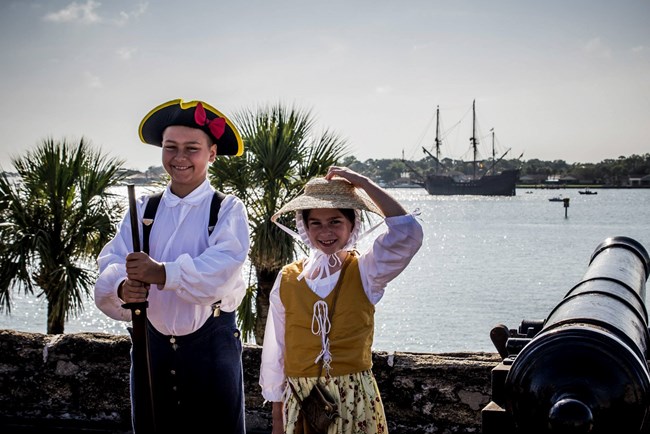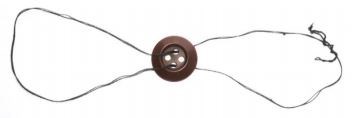Last updated: April 25, 2025
Article
Colonial Games

Background
In the 16th century, even though native people occupied the land, Spain, England, France, and other European nations started to claim and settle the Americas. St. Augustine was established by the Spanish in 1565. Even though it's had many owners, St. Augustine is the oldest permanently occupied European settlement in what's now the United States.
Colonial Life
What was it like in the colonies? Most colonies existed to benefit European nations. St. Augustine's forts protected the Gulf Stream, Spain's treasure route. The forts also protected the people of St. Augustine. These colonists, who were adventurers, soldiers, missionaries, indentured servants, and tradesman, had to work very hard to settle and survive in a new place so far away from Europe. All the men who were physically healthy had to serve in the military, but they also had to run farms, businesses, and trade to support themselves. Women were expected to run the homes and raise the children. Children had a lot of chores to do to help their families survive. Boys would chop wood, feed animals, and hunt. Girls would grind corn, spin, and weave. Many poorer children did not go to school. They learned to farm, hunt, cook, and sew from their families.

Even though colonial kids worked hard, they still found time for outdoor fun, like swimming, fishing, and flying kites.
How do you spend your free time? What games and toys do you usually play? Ask your parents and grandparents, what did they like to play when they were young?
Games and instructions were shared through stories instead of being written down. One generation would pass it on to the next generation. History was also shared orally through stories instead of being written down.
One example is that today, kids play a lot of games on their computers and mobile devices. Playing with technology, helps prepare children to use technology as students and adults. The use of computers is a big change from colonial days, but the idea that playing games could prepare you for adulthood has not changed.
A second example is that colonial children played with dolls. Dolls were used to teach kids to care for little siblings or how to be parents when they grew up. Kids today still play with dolls and these reasons still apply. The idea hasn’t changed, but instead of homemade dolls, kids today usually have factory produced dolls. Plus, today’s dolls come in many sizes and shapes!
You may be familar with some colonial games and toys. Have you ever played tag, hide-and-seek, hopscotch, yo-yo, puzzles, dominoes, marbles, pick-up sticks, jump rope, spinning tops, leap frog, card decks, dice, and dolls? See if you can identify a few of the images below.
Guessing Game
Left image
Question: What is it?
Right image
Answer: slide to reveal
Also known as Cup-and-ball, Ring and Pin, and Bilboquet, this is a traditional children’s toy dating back to the 14th century. It is popular in Spanish-speaking countries, where it is called by a wide number of names, like balero. In North America, it was both a child’s toy and a gambling mechanism for adults, and involved catching a ring rather than a ball. In simple cup and ball toys, the ball is tossed and caught in a cup on the end of a stick. In a more difficult version, the ball is caught on the top of a spindle by a hole drilled in the ball opposite the string.
Left image
Question: What is it?
Right image
Answer: slide to reveal
This game was played in early America as it had been played for over two thousand years, with small sheep knucklebones. The game was known as knuckles, knucklebones, dibs, or jackstones. Small pebbles or marbles were sometimes substituted for the bones. To play, hold five knuckles in your hand. Throw them up, turn your hand over quickly and catch as many as you can on the back of your hand. Eventually, metal jacks were produced and replaced the sheep bones.
Left image
Question: What is it?
Right image
Answer: slide to reveal
Known commonly today as checkers, Draughts (pronounced “drafts”), also known as Dames, was created in France in the 12th century as a game to be played on a Chess board where all the pieces moved like Medieval Chess Queens. This is a simple game for two players to move their pieces diagonally capturing opponents by jumping them. When a piece reaches the opposite end of the board, it becomes a Queen or King. This is designated by placing a captured piece on top of it. The Queen or King may move and capture forward or backward. Play continues until one player can no longer move.
Left image
Question: What is it?
Right image
Answer: slide to reveal.
This is a bowling game that probably originated in continental Europe during the Middle Ages. The game of ninepins was brought to America by early Dutch colonists. A variety of pins, balls, and rules of play developed as bowling games evolved into the games we know today as skittles, duckpins, law bowls, bocce, and tenpins. Ninepins can be played with 2 or more players. The object of the game is to knock down as many of the wooden pins as possible with each roll of the ball. The first player to score exactly 31 points is the winner.
Left image
Question: What is it?
Right image
Answer: slide to reveal
This whirligig is fashioned from a Spanish Dollar, also known as the piece of eight, a silver coin widely used during the 18th and early 19th centuries. There are many variations of this toy, including the buzz saw. Buzz saws were usually wood, instead of metal, and made a buzzing sound as you played. In far-flung cultures and throughout history, buzzers have been made by and for children from all sorts of materials and in a variety of shapes and sizes. To learn more, make your own and give it a try!
Activity
The whirligig is the old version of the fidget spinner! Try your hand at making your own.Materials:
2-3 feet of string, yarn, or thin ribbon1 large button or other round, button shaped object
1 pair of scissors
One or more adults to assist you
Instructions:
Cut a length of string approximately 3 feet long. Thread the string through one hole in the button and then through the hole directly across. Tie both ends of the strong together into a knot. From the back of the button, pull the string until the button is in the center.
How to Play:
Place the loop formed at each end of the doubled string over two fingers of each hand and slide the button to the middle of the string. With tension on the string, move your hands in a circular motion so that the button spins away from you and the string becomes twisted along its entire length. When the string is completely wound, simultaneously stop the circular motion and pull your hands apart gently, in a continuous motion. The button will start to spin back toward you. Bring your hands toward each other just a bit to allow the string to rewind, then apart again each time the string is fully wound, in a gentle and rhythmic motion, slowing or quickening the speed of the whirligig by adjusting the timing and strength of your pull.
If you enjoyed learning about colonial games, you may also enjoy you may also enjoy our Build Your Own Fort or Build Your Own Cannon activities.
